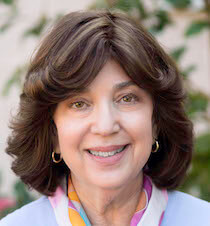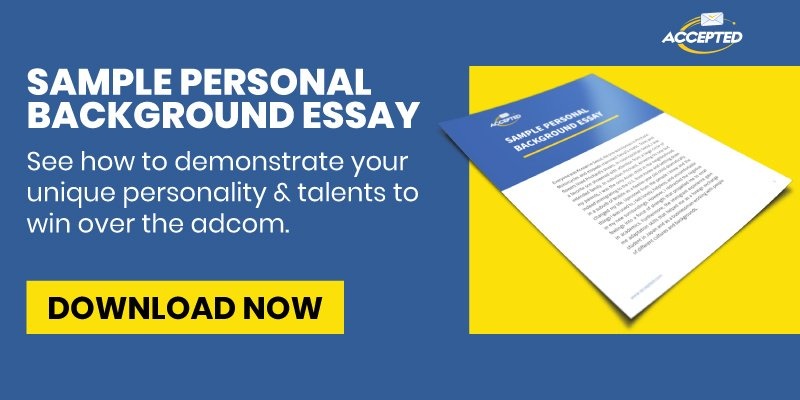|
7 Simple Steps to Writing an Excellent Diversity Essay |
||
7 Simple Steps to Writing an Excellent Diversity Essay


What is the diversity question in a school application, and more importantly, why does it matter when applying to leading programs and universities?
A diversity essay is an essay that encourages applicants with minority backgrounds, unusual education, distinctive experience, or unique family histories to write about how these elements will contribute to the diversity of their target school’s class and community.
In this post we’ll cover:
- How to show you add to diversity
- Why diversity matters at school
- 7 different ways to show your diversity
- How to write about your diversity
- Diversity essay example
How to show you add to diversity
If you are an immigrant to the U.S., the child of immigrants, or someone whose ethnicity is a minority in the U.S., your response to this question may help your application effort. Why? Because you can use it to show how your background will add to the mix of perspectives at the program you are applying to.
Download this sample personal background essay, and see how one student won over the adcom and got accepted into their top-choice MBA program.
Of course, if you’re not an under-represented minority and don’t fall into one of those categories, that doesn’t mean that you don’t have anything to write about.
For example, you may have an unusual or special experience to share, like serving in the military, being a member of a dance troupe, or caring for a disabled relative. These and other distinctive experiences convey how you will bring diversity to the school’s campus.
You could be the first member of your family to apply to college or the first to learn English in your household; you could have worked your way through college or helped raise your siblings.
As you can see, diversity is not limited to one’s religion, ethnicity, culture, language, or sexual orientation. It’s whatever element of your identity distinguishes you from others.
Why does diversity matter at school?
Admissions officers believe diversity in the classroom improves the educational experience of all students.
The more diverse perspectives found in the classroom, throughout the dorms, in the dining halls, and mixed into study groups, the richer the discussions will be and the more creative the teams will become.
Plus, learning and growing in this multicultural environment will prepare students for working in our increasingly multicultural and global world.
In medicine, for example, a heterogeneous workforce benefits people from previously underrepresented cultures in medicine. Businesses realize they will market more effectively if they can speak to different audiences and markets. Schools simply want to prepare graduates for the 21st-century job market.
Listen to this podcast episode and find out how to approach diversity in your application >>
7 different ways to show your diversity
Adcoms want to know about your diversity elements and the way they have helped you develop particular character and personality traits, as well as the unusual experiences that have shaped you.
Here are seven examples you could write about:
- You grew up with a strong insistence on respecting elders, attending family events, or learning your parents’ native language and culture.
- You are close to grandparents and extended family who have taught you how teamwork can help everyone thrive.

- You have had to face difficulties that stem from your parents’ values being in conflict with yours or those of your peers.
- Teachers have not always understood the elements of your culture or lifestyle and how they influence your performance.
- You suffered from discrimination and succeeded despite it because of your grit, values, and character.
- You learned skills from a lifestyle that is outside the norm – living in foreign countries as the child of diplomats or contractors; performing professionally in theater, dance, music, or sports; or communicating with a deaf sibling.
- You’ve encountered racism or other prejudice (either towards yourself or others) and responded by actively promoting diverse, tolerant values.
And remember, it’s not just about who your parents are. It’s about who you are – at the core.
Your background, influences, religious observances, language, ideas, work environment, community experiences – all of these factors come together to create a unique individual, one who will contribute to a varied class of distinct individuals taking their place in a diverse world.
How to write about your diversity
Your answer to the diversity question should focus on how your experiences have built your empathy for others, your resilience, your character, and your perspective.
The school may well ask how you think of diversity or how you can bring or add to the diversity of your school, chosen profession, or community. Make sure you answer the specific question posed by highlighting a distinctive you that will add to the class mosaic every adcom is trying to create. You don’t want to blend in; you want to stand out but also complement the school’s canvas.
Here’s a simple, three-part framework that will help you think of diversity more… well diversely:
- Identity: Who are you? What has contributed to your identity? How do you distinguish yourself? Your identity can include any of the following: gender, sexual orientation, ethnicity, disability, religion, non-traditional work experience, non-traditional educational background, multicultural background, and family’s educational level.
- Deeds: What have you done? What have you accomplished? This could include:
a. Achievements inside and outside your field of study
b. Leadership opportunities
c. Community service
e. Internship or professional experience
f. Research opportunities
g. Hobbies
h. Travel
Any or all of these could be unique. Also, what life-derailing, throw-you-for-a-loop challenges have you faced and overcome?
- Ideas: How do you think? How do you approach things? What drives you? What influences you?
Learn more about this three-part framework in this blog post.
Think about each question and how you could apply your diversity elements to the classroom, your school, or your community. Any of these elements will serve as the framework for your essay.
Don’t worry if you can’t think of something totally “out there.” You don’t need to be a tightrope walker living in the Andes or a Buddhist monk from Japan to pass the diversity test!

And please remember, the examples I have listed are not exhaustive. There are many other ways to show diversity!
All you need in order to write successfully about how you will contribute to the rich diversity of your target school’s community is to examine your identity, deeds, and ideas, with an eye towards your own distinctiveness and individuality. There is only one you.
Take a look at this sample diversity essay and pay attention to how the writer underscores their appreciation for and experience with diversity:
Diversity essay example
When I was starting 11th grade, my dad, an agricultural scientist, was assigned to a 3-month research project in a farm village in Niigata (northwest Honshu in Japan). Rather than stay behind with my mom and siblings, I begged to go with him. As a straight-A student, I convinced my parents and the principal that I could handle my schoolwork remotely (pre-COVID) for that stretch. It was time to leap beyond my comfortable suburban Wisconsin life—and my Western orientation, reinforced by travel to Europe the year before.
We roomed in a sprawling farmhouse with a family participating in my dad’s study. I thought I’d experience an “English-free zone,” but the high school students all studied and wanted to practice English, so I did meet peers even though I didn’t attend their school. Of the many eye-opening, influential, cultural experiences, the one that resonates most powerfully to me is experiencing their community. It was a living, organic whole. Elementary school kids spent time helping with the rice harvest. People who foraged for seasonal wild edibles gave them to acquaintances throughout the town. In fact, there was a constant sharing of food among residents—garden veggies carried in straw baskets, fish or meat in coolers. The pharmacist would drive prescriptions to people who couldn’t easily get out—new mothers, the elderly—not as a business service but as a good neighbor. If rain suddenly threatened, neighbors would bring in each other’s drying laundry. When an empty-nest 50-year-old woman had to be hospitalized suddenly for a near-fatal snakebite, neighbors maintained her veggie patch until she returned. The community embodied constant awareness of others’ needs and circumstances. The community flowed!
Yet, people there lamented that this lifestyle was vanishing; more young people left than stayed or came. And it wasn’t idyllic: I heard about ubiquitous gossip, long standing personal enmities, busybody-ness. But these very human foibles didn’t dam the flow. This dynamic community organism couldn’t have been more different from my suburban life back home, with its insular nuclear families. We nod hello to neighbors in passing.
This wonderful experience contained a personal challenge. Blond and blue-eyed, I became “the other” for the first time. Except for my dad, I saw no Westerner there. Curious eyes followed me. Stepping into a market or walking down the street, I drew gazes. People swiftly looked away if they accidentally caught my eye. It was not at all hostile, I knew, but I felt like an object. I began making extra sure to appear “presentable” before going outside. The sense of being watched sometimes generated mild stress or resentment. Returning to my lovely tatami room, I would decompress, grateful to be alone. I realized this challenge was a minute fraction of what others experience in my own country. The toll that feeling—and being— “other” takes on non-white and visibly different people in the US can be extremely painful. Experiencing it firsthand, albeit briefly, benignly, and in relative comfort, I got it.
Unlike the organic Niigata community, work teams, and the workplace itself, have externally driven purposes. Within this different environment, I will strive to exemplify the ongoing mutual awareness that fueled the community life in Niigata. Does it benefit the bottom line, improve the results? I don’t know. But it helps me be the mature, engaged person I want to be, and to appreciate the individuals who are my colleagues and who comprise my professional community. I am now far more conscious of people feeling their “otherness”—even when it’s not in response to negative treatment, it can arise simply from awareness of being in some way different.
What did you think of this essay? Does this middle class Midwesterner have the unique experience of being different from the surrounding majority, something she had not experienced in the U.S.? Did she encounter diversity from the perspective of “the other”?
Here a few things to note about why this diversity essay works so well:
- The writer comes from “a comfortable, suburban, Wisconsin life,” suggesting that her own background may not be ethnically, racially, or in other ways diverse.
- The diversity “points” scored all come from her fascinating experience of having lived in a Japanese farm village, where she had been immersed in a totally different culture.
- The lessons learned about the meaning of community are what broaden and deepen the writer’s perspective about life, about a purpose-driven life, and about the concept of “otherness.”
By writing about a time when you experienced diversity in one of its many forms you can write a memorable and meaningful diversity essay.
Working on your diversity essay?
Want to ensure your application demonstrates the diversity that your dream school is seeking? Work with one of our admissions experts and download our FREE Diversity Checklist. This checklist includes 30+ different ways to think about diversity to jump-start your creative engines.

By Linda Abraham, president and founder of Accepted. Linda earned her bachelors and MBA at UCLA, and has been advising applicants since 1994 when she founded Accepted. Linda is the co-founder and first president of AIGAC. She has written or co-authored 13 e-books on the admissions process, and has been quoted by The Wall Street Journal, U.S. News, Poets & Quants, Bloomberg Businessweek, CBS News, and others. Linda is the host of Admissions Straight Talk, a podcast for graduate school applicants. Want an admissions expert to help you get accepted? Click here to get in touch!
Related Resources:
• Different Dimensions of Diversity, a podcast episode
• What to Do if You Belong to an Overrepresented Applicant Group
• Med School Admissions Advice for Nontraditional Applicants: The Experts Speak
The post 7 Simple Steps to Writing an Excellent Diversity Essay appeared first on Accepted Admissions Blog.


[0] Comments to this Article